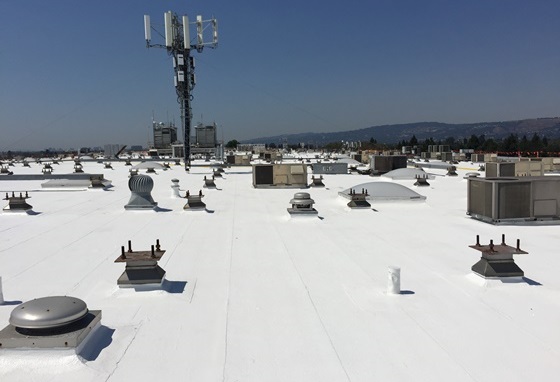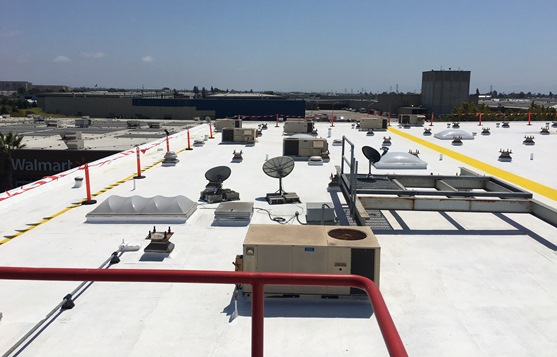Located in the San Francisco Bay Area of Northern California, the WestGate San Leandro is a massive 413,000-square-foot (38,369.0 m2) multi-use office and retail complex owned by real estate development group WestGate Ventures, LLC. But even in that desirable location, roofs nearing the end of their projected lifespan can devalue prized assets.
Fortunately for tenants, this complex is run by a proactive owner who wanted to address any problems with the built-up cap sheet roof before it was too late.
“The existing roof, while still in pretty decent shape, was old,” said Jesse Reed, project manager with contractor Bigham Taylor Roofing Corp. “We guessed it was around 25 years old. I think the owner’s long-term plan is to sell the property, and they had always included a lot of capital projects to get the building up to current market standards.”
The owner couldn’t afford for a failing roof system to drive away interest!
So the client chose a new silicone roof coating system instead of doing a complete tear-off. “This was the best bang for the buck,” Reed said. “Any roof demolition or even overlaying a new single-ply roof would’ve been much more expensive.”
The complex’s size made it a multi-month job, and given the Bay Area’s often wet climate, Reed’s 10- to 12-person crew began installing the new system in May 2017 — just as the dry season kicked off.
Comfort of Home
Founded in 1977, Bigham Taylor employs ~130 people and is based in nearby Hayward, California. On this job, proximity proved crucial on multiple fronts.
“The project location was like 5 miles [8 km] away from our shop, so mobilization was easy,” Reed said. “That definitely benefited us.”
“This was a very interesting building,” Reed added. “It used to be an old manufacturing plant, so it’s very heavy-duty. Because of that, we could drive our vehicles to the second floor, which allowed us to get our totes and pumps close to the working area. We’d remove a skylight and then pump through the skylight, because there were skylights all over. It made it a lot easier to get material to the roof.”
Another benefit was that one retail tenant was a Home Depot!
“We could just go downstairs and buy whatever extra equipment we needed,” Reed explained. “A lot of our guys were just using a standard 12-inch [30.5 cm] paint roller with a nap. We didn’t need larger rollers, just standard rollers on broom handles to roll out the silicone.”
‘Homework’ Pays Off
Before the crew could apply the new system, several introductory steps had to be taken to ensure a safe workplace with minimal disruptions.
To start, Bigham Taylor requires wearing full personal protective equipment (PPE), including safety glasses, boots, long sleeves and pants, hard hats, and safety harnesses from local supplier RoofMaster Products Co., when working near skylights and low parapet walls below 42 inches (106.7 cm). Other considerations included timing the shutdowns of cell towers, thus allowing crew members to work around cell antennae for national carriers.

Aside from safety precautions, communication was another priority.
“There were four or five smaller, detached buildings, and we also had to do all of those,” Reed explained. “It took a lot of coordination with various tenants. But it went pretty darn smoothly for as big of a job as it was. The client was great to work with. The whole building was undergoing a large renovation and doing lots of other projects besides the roofing scope, such as painting and replacing windows. The site was geared up for lots of construction, so everybody was pretty accommodating.”
Compared to other trades, the roofers may have posed the least disruption.
“Because it’s a coating, you don’t have a lot of noise other than hearing footsteps and pails being sent down,” Reed said. “You’re not doing demolition, you’re not ripping off an old roof. Overall, the disruption was pretty minimal.”
Final Application Test
With those precautions taken, the crew worked quickly to apply the two-part system before the rainy season. Surface preparation consisted of cleaning to remove debris, dust, and any contaminants, which the crew conducted using blowers, again from Home Depot. Meanwhile, the coating manufacturer also required wrapping any pipes, vents, and curb corners in polyester and with a butter-grade silicone coating in order to receive the desired 15-year warranty.
Once an area was prepped, the crew applied the Roof Primer A504 from National Coatings Corp., described as a dark water-based primer that dries quickly and accelerates the evaporation of morning condensation to reduce topcoat application time. Using a Graco rig, the primer was sprayed out at a rate of 1 gallon (3.8 L) per roofing square (0.09 m²).
After applying the primer, the SRC 720 high-solids white silicone roof coating was rolled out at a rate of 2 gallons (7.6 L) per roofing square (0.09 m²). The single-component, moisture-cured, fluid-applied silicone provides elemental protection for architectural surfaces.
“Using the rollers worked really well because we could keep the application rate consistent,” Reed said. “We knew one 5-gallon [18.9 L] pail would cover two-and-a-half squares [0.2 m²], so we could basically map out that every pail would cover a certain amount. Then the guys could roll it all out, and that kept it very consistent over a large area.”
Bigham Taylor effectively divided its crew into two teams. This allowed them to work in tandem — with one crew spraying the primer, and the other rolling out the silicone. Crew members who weren’t directly applying the coatings were conducting other associated tasks, such as moving equipment and material; doing advance prep work around curbs and vents; and checking for any safety issues, such as proximity to skylights.
“We would try to spray out several squares ahead, let it dry for a day or two, and then follow it up with the silicone. So we were spraying up to 40, 50, or even 100 squares [3.7, 4.6, or 9.3 m²] ahead getting the primer,” Reed explained.
The finishing touch involved applying RoofGuard Granules. “After the silicone, we broadcast the granules so that we’d have a slip-resistant surface,” Reed said. White granules were applied all over at 18 lbs. (8.2 kg) per roofing square (0.09 m²).
The crew also painted yellow silicone walk paths on top to specific areas where foot traffic was likely, such as service doors and concentrations of heating, ventilation, and air conditioning (HVAC) units. The yellow SRC Safety Coating from National Coatings Corp. was rolled out at 1.5 gal (5.7 L) per roofing square (0.09 m²), while yellow granules were broadcast in at ~60 lbs. (27.2 kg) per roofing square (0.09 m²). “The yellow was much more heavy duty to provide extra slip resistance,” Reed explained.
Ready for Sale?
It took three months to coat everything, but using that diligent and measured process, the Bigham Taylor crew wrapped up the job before the dry season ended. Thus far, the feedback has been as good as it gets.
“They’ve been very happy,” Reed said of the client, who received the full warranty. “We haven’t had a ton of rain yet in Northern California this year, but we haven’t heard of any roof leaks. The National Coatings rep was very pleased. He did his mil thickness sampling, and everything was really consistent and applied as required. They said it was one of the better silicone systems they’ve ever seen put down.”
If the client decides to sell, that’s one huge item off its checklist!
